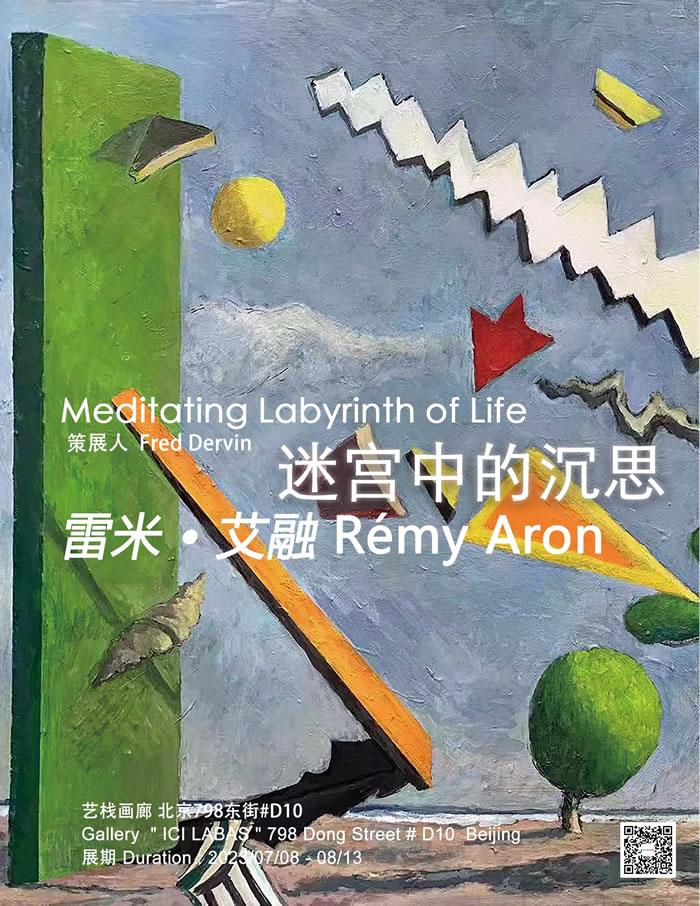
展覽名稱:迷宮中的沉思——雷米·艾融個展
策展人:Fred Dervin
開幕時間:2023年7月9日 下午3時
展覽時間:2023年7月8日-8月13日
展覽地點:ICI LABAS藝棧畫廊,798東街#D10
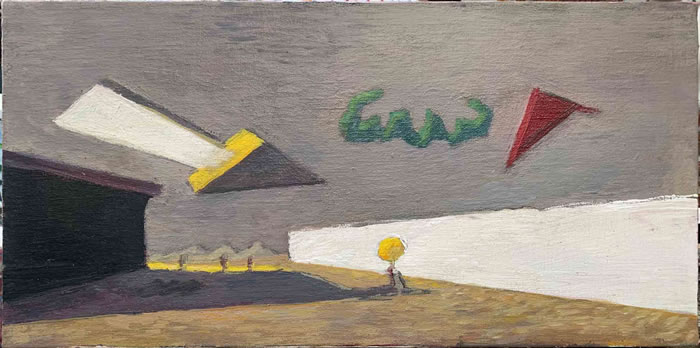
Un soleil du matin 清晨的陽光 25x50
在生活的混亂和迷宮中沉思
Fred Dervin 教授 (芬蘭)赫爾辛基大學
譯者: 陳寧 (芬蘭)赫爾辛基大學;天津美術學院
“我的畫是流動的,我試圖平衡空間和表面(可以理解為將三維空間和二維的事物),以便達到內在的和諧統一……”
“我的繪畫始於混亂,終於有序。”
這是法國當代著名畫家對於他自己藝術創作的描述。出生於1952年的雷米·艾融,畢業于巴黎美術學院桑吉耶工作室,中國國家畫院成員,法國美術家協會主席,空間主義藝術運動發起人 。
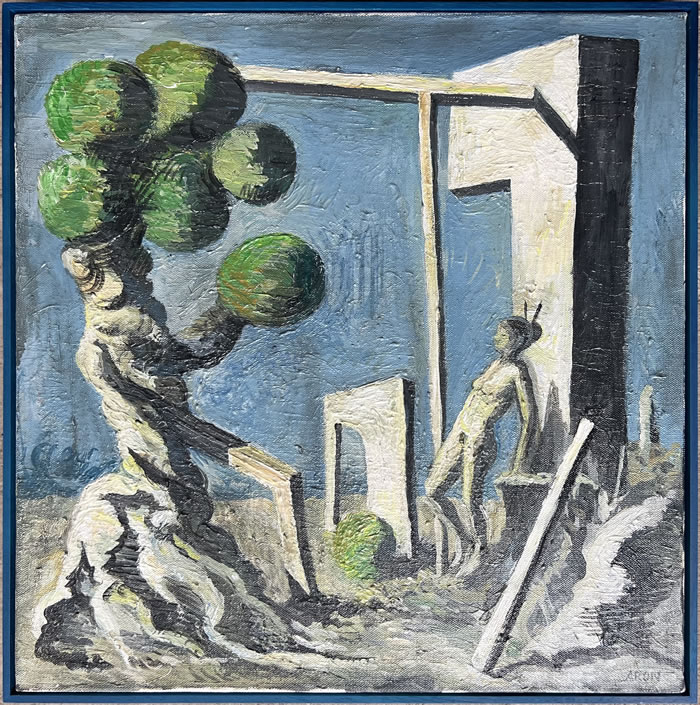
Un étonnement 驚訝 40x40
當觀眾進入展覽的那一刻,每個人就像進入了我稱之為“迷宮”的地方,藝術家以其謙遜的態度誠邀大家參觀他的展覽。在此次展覽中,我以“迷宮”的主題和隱喻來作為本次展覽的中心。
迷宮是一個封閉而蜿蜒的建築群(方形或螺旋形),由房間和走廊組成,有對稱和規則的形狀、交叉點、死角和假軌道,我們難以理解和把握。形象地説,迷宮這個詞在許多語言中經常被用來指代複雜的情況或曲折的推理。迷宮的詞源可以指用於祭祀公牛的(雙)斧頭。 據説迷宮也來自拉丁語的勞動(labor intus),表示一項艱巨的任務。同樣,在雷米·艾融 (Rémy Aron) 在曲折的“迷宮”中穿行並不容易,即使他的作品中存在我們熟悉的東西和反覆出現的事物,但這種“誤解”需要通過往復的觀察去找到答案,從而獲取理解。
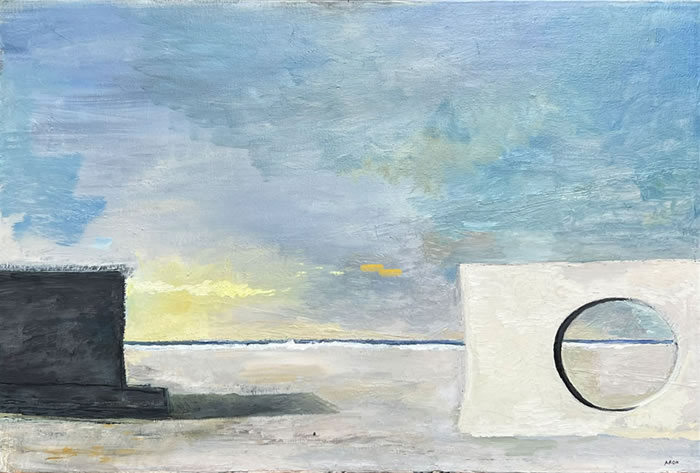
安靜
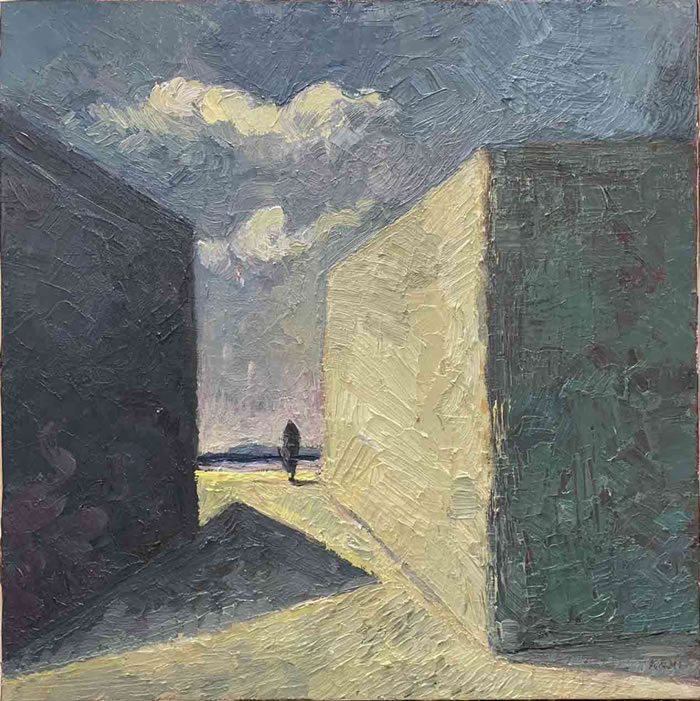
Un arbre au bout de la rue 街盡頭的一棵樹 40x40

Une attente à l'intérieur 內部的期望 40x40
迷宮的美學主題和隱喻經常被跨時代和跨地區使用。 迷宮象徵著彎路、欺騙、流浪,同時也象徵著危險。當我反覆欣賞艾融的每件作品,越發能感受到每幅作品“化繁為簡”的力量。艾融將一切靜止的、常見的事物有序的拼湊在作品中,在他創作的看似靜止又相對流動的事物背後,是他喚起我們對生活進行沉思。
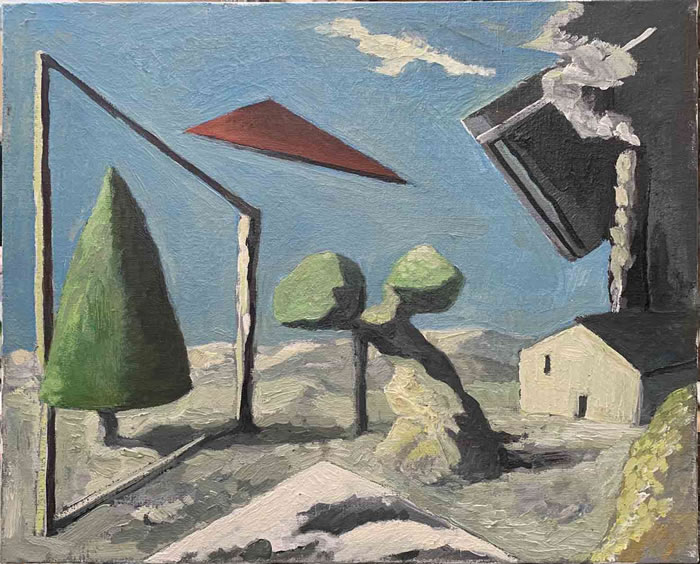
Un matin calme 安靜的早晨 41x33
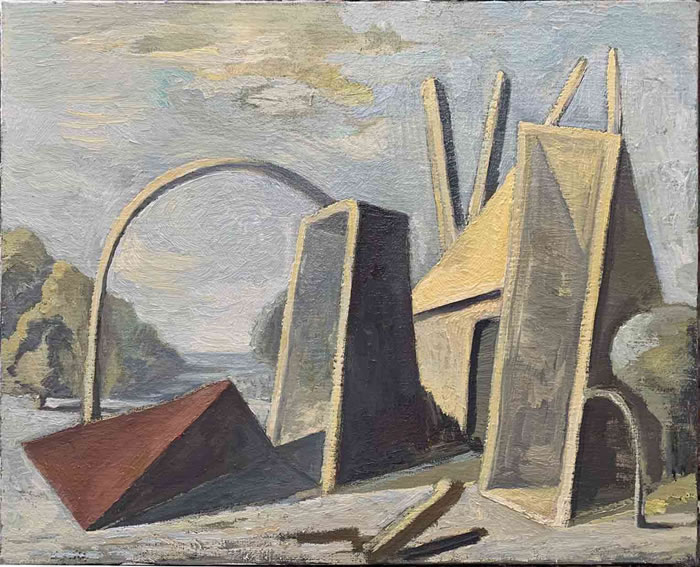
Architecture et bord de mer 建築和海邊 41x33
詩人和藝術評論家讓-克拉倫斯·蘭伯特 (Jean-Clarence Lambert) 説:“迷宮一直伴隨著人類,並存在於世界各地。當人類試圖創造世界,以及創造命運的時候,迷宮對他來説可能就像圓、直線、橢圓或正方形一樣必要。” 迷宮的兩種形式:單線(只有一條路的迷宮,一條曲折的道路,但沒有死衚同,你不會迷路)和多線(複雜的迷宮迴圈,死衚同;我們只能迷路)。 艾融的展覽就像一個多線迷宮,每幅畫代表一個迴圈或死衚同,讓觀眾體驗到不同的感受。
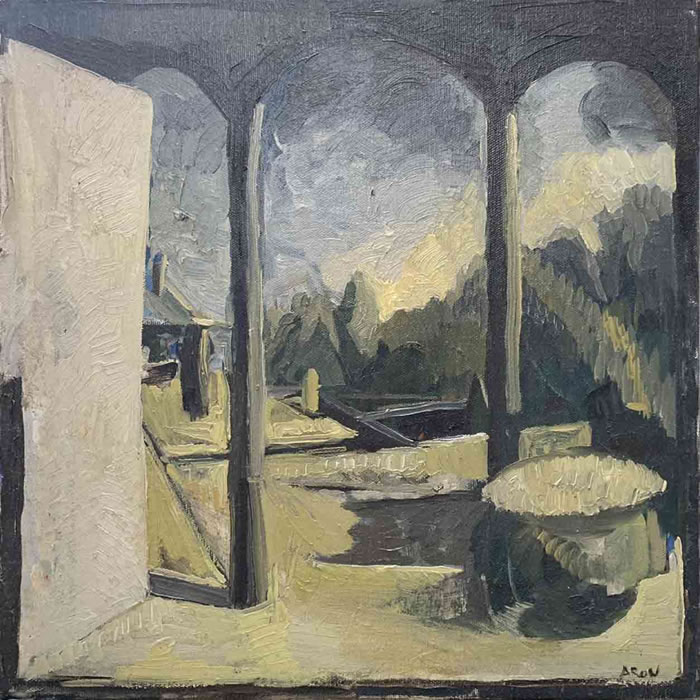
Un mur et arcades 一堵墻和拱廊 40x40
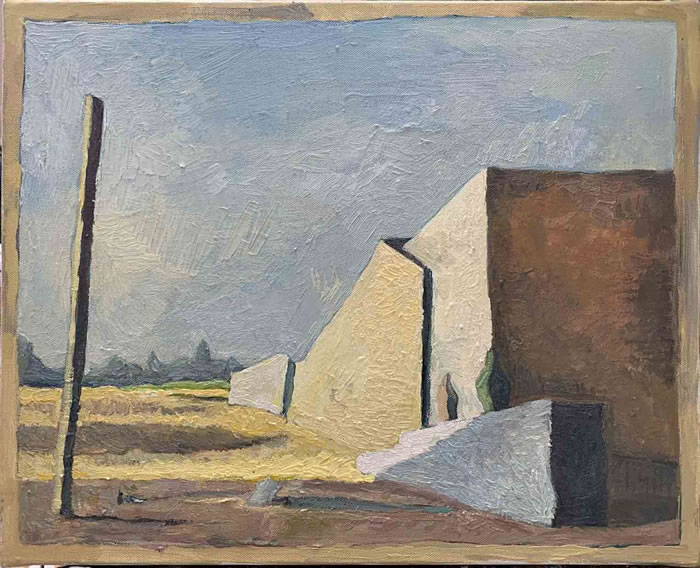
Un beau soleil du soir一個美麗傍晚的太陽 41x33
那麼我為什麼用迷宮來隱喻本次展覽呢?首先,迷宮的隱喻經常出現在在藝術、文學、文藝復興時期的花園藝術、數學甚至電腦科學中。更重要的是,反觀歷史,許多文明早已利用迷宮的形式,將它們篆刻在不同的地方。埃及人把迷宮變成了宗教建築,從而象徵世界。在希臘神話中,迷宮是代達羅斯建造的一座宮殿,用來封閉和隱藏半人半牛的牛頭怪。英雄忒修斯在這個迷宮中殺死了彌諾陶洛斯,多虧了所謂的阿麗亞娜導線,他才得以逃脫。在中世紀,教堂裏有迷宮,畫在地板上,為了誘捕惡魔,因為當時人們認為惡魔只知道如何沿著直線前進。迷宮也是基督徒獲得救贖的困難。在印度,以軸線為中心的幾何圖形,曼荼羅(梵語中的圓圈)作為冥想工具,也有一個迷宮般的形狀,讓人想起人體的“地圖”,房子,還有皇家宮殿的平面圖。18世紀前的中國沒有實景迷宮(但18世紀前中國有很多書籍中記載了很多類似于迷宮的論述),後來耶穌會士為乾隆皇帝建造了第一座實景迷宮(圓明園中的萬花園,目前為原址重建),靈感源自於中國的園林。迷宮的形式也出現在其他中國建築元素中,如皇宮和陵墓(在漢語中,迷宮一詞的意思是“令人迷惑的宮殿”)。這種迷宮所代表的深度和廣度正和艾融的藝術作品傳達的精神不謀而合,將喜與悲,生與死貫穿始終。
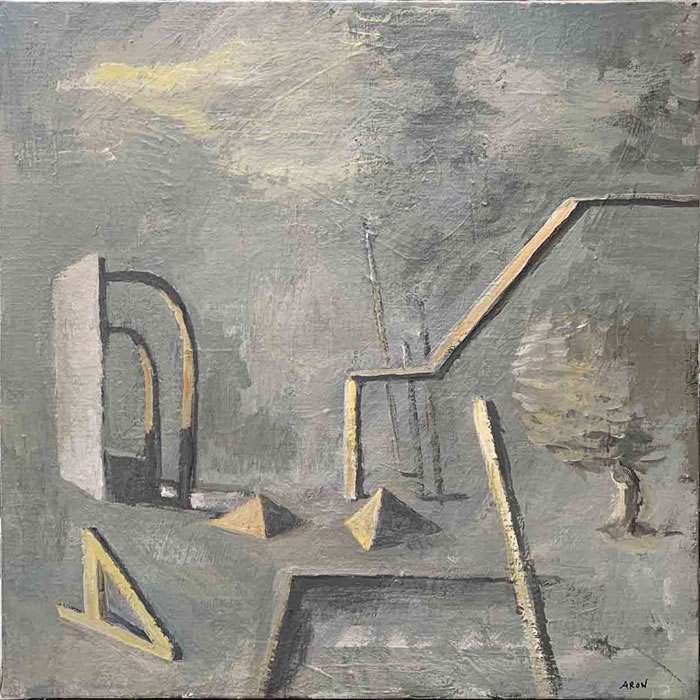
Espace et choses空間和事物 40x40
在不同的時代和空間中,迷宮就像整個人類的發展一樣,夾雜著秩序與混亂。迷宮即反映了人類無限的創造力和潛力,同時也使其迷失方向並帶來挫折。但迷宮始終有始有終。它鼓勵我們去冒險,去探索、去觀察、去前進、去遊歷、去選擇、去猶豫……就像西方的西西弗斯(希臘神話中因觸犯眾神而受到懲罰)或中國的吳剛(受懲戒在月宮裏伐樹的仙人),即使這些任務看起來單調而毫無意義,我們也別無選擇。我們必須繼續堅持下去。加繆[1](1913-1960)認為(《西西弗斯神話》),儘管西西弗斯受到了不公正的懲罰,但他還是“快樂”的。最後,詹姆斯·喬伊斯[2](James Joyce, 1882-1941)也在“迷宮”中看到了藝術家處境(《一個青年藝術家的自畫像》的一個顯著藝術特點就是迷宮藝術)……
現在讓我們回到藝術家艾融。 在本次展覽作品中,藝術家的作品放大了我們“生活迷宮”的角落和縫隙。 我們並不知道自己身處何地,每件作品就像一個生活中處處可見的微小角落。 他並沒有從一開始就指明方向,而是通過事物的混亂和複雜引發觀眾的沉思與共鳴。艾融想讓每一個觀眾,停下來思考,反思過去,嚮往未來。迷宮沒有起點,也沒有終點。艾融向我們展示了墻壁、走廊、門、角落和縫隙……但沒有出路。我們在迷宮中或迷失,或沉思,然而我們終將找回自我,在生活的迷宮中與世界共存。
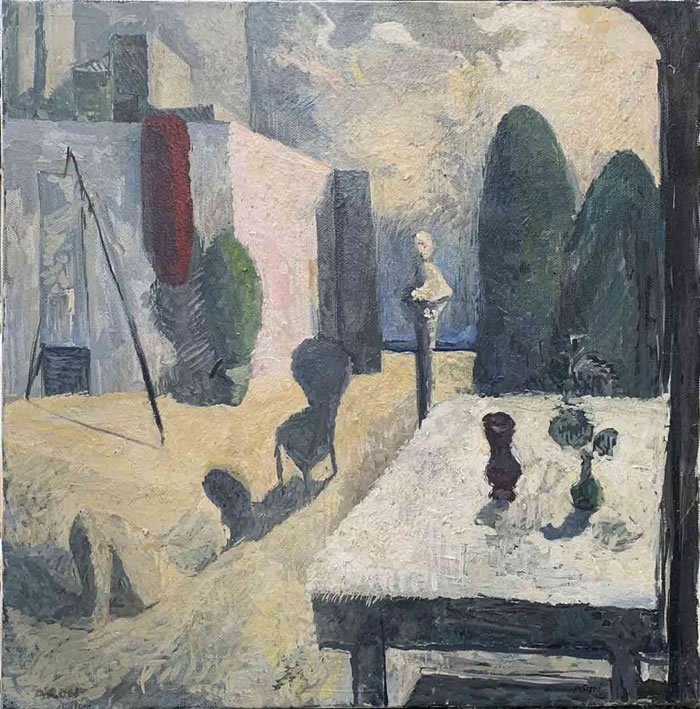
Dans la cour 庭院中 40x40
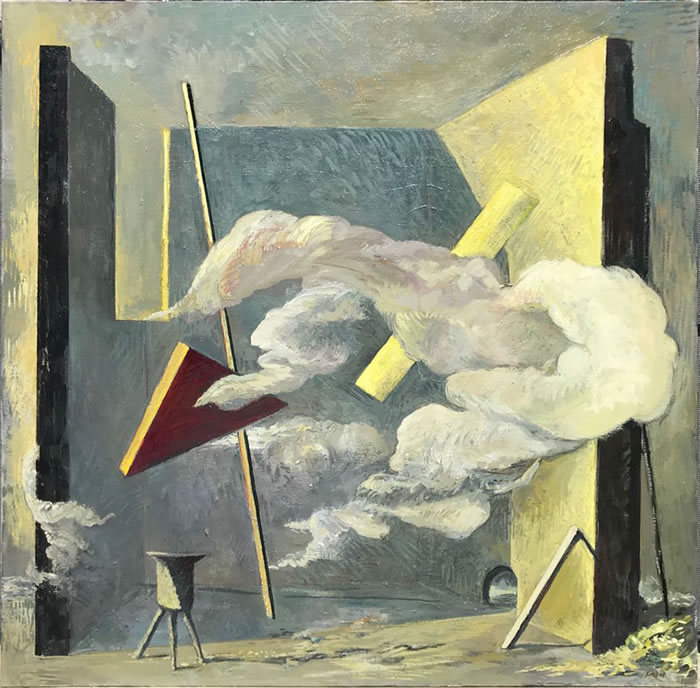
Intérieur de l'espace 室內空間 100x100cm
雷米·艾融談及他的作品時説:(它是關於)自我發現、冒險和意外發現……就好像我的創作很長一段時間都是與自然相關,我沉迷于空間和奇觀。但今天展覽的主題,始於自我的混亂。當我在工作的時候,我需要和時間、空間、光線産生共鳴,忘我的投入,達到“天人合一”的境界。我尋求自然與構圖的平衡,通過色彩相互關聯,探究人、事、物之間的關係。
藝術家在這裡通過他自己的存在哲學為我們描繪了生活迷宮的“一部分”:“世界奇觀”、“混沌”、“空間與光”、“和諧統一”。本次展覽正如迷宮不會對試圖穿過它的人施加任何影響一樣,藝術家讓我們在觀賞後進行深思。
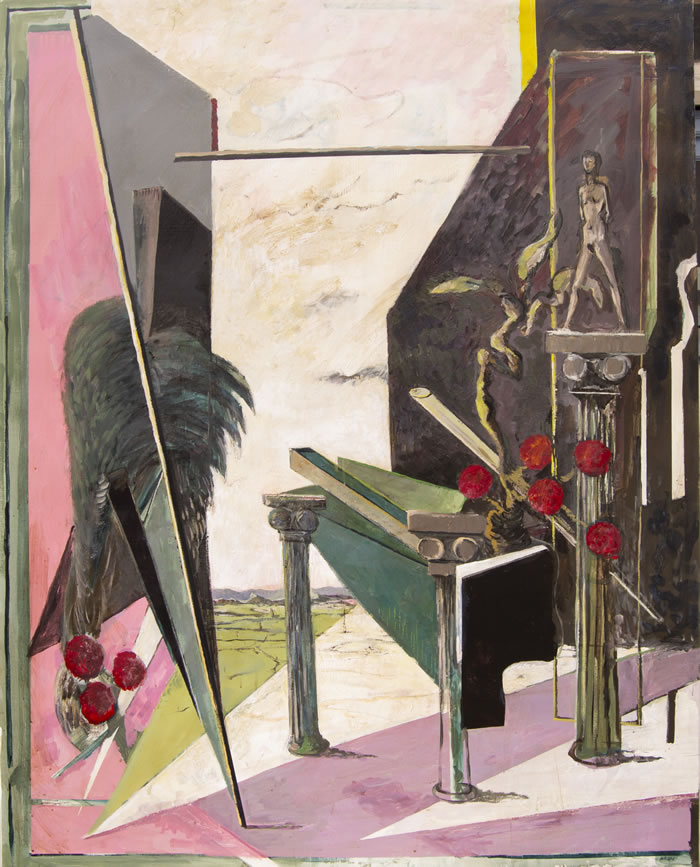
Les trois colonnes三列柱子 162x130cm
當我們欣賞艾融的畫作時,我們是自由的,我們可以去任何的地方、任何的角落,在去到任何一幅畫的地方,甚至任何一幅畫中的某一角落。但即使你有所“迷失”,你也會通過忽明忽暗的色彩找到“出口”。艾融大多數藝術作品的共同點是地面、天空和地平線的無所不在,即使它們有時因為“交匯融合”而重合或隱藏。儘管艾融的作品中可能會讓你感覺到風景或者事物的“反覆”,你會覺得自己陷入了迷宮的迴圈,你會覺得陷入混亂與迷茫,但艾融在他的每幅作品中都留有“線索”但我們需要集中注意力去反覆觀賞,才能夠從陌生到熟知。
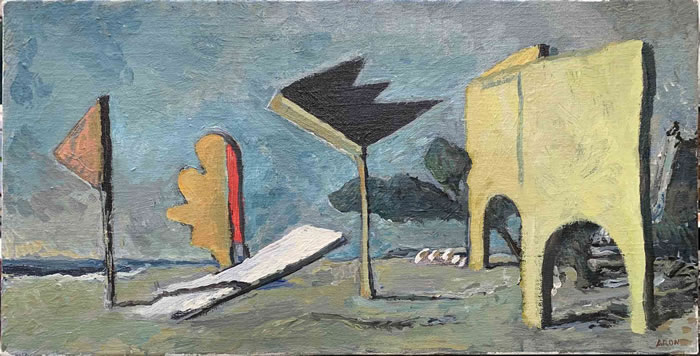
Les directions et la lumière 方向和光線 25x50
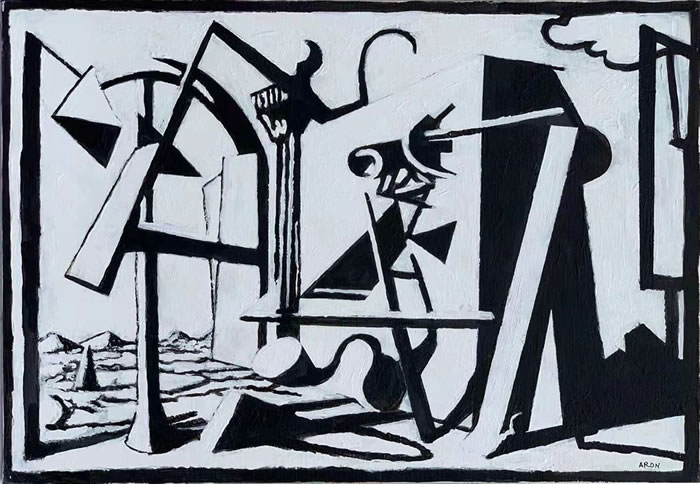
Constructions 建築工程 50x72cm
因此,我們在繪畫中可以獲取熟悉的暗示:特定的地方(海灘、房屋、山脈、墻壁、通向世界的窗戶); 自然元素(樹木、植物、靜物、花束、雲); 反覆出現的形狀(不斷變換顏色的三角形、箭頭、線條、空氣流動、螺旋)、事物(獎盃、中國的燈、隨風飄揚的窗簾、讓我們想起用於在迷宮中定位自己的阿麗亞娜導線)。這些元素將我們帶入到這個不斷運動變化發展的宇宙中。但人去哪了?人物形象在艾融的畫作中很少見。人是零星的,是被動的,人成了“裝飾”的一部分。他們在等待,在睡覺,在做夢,在猶豫,在懷疑,在害怕,他們躲了起來。一些事物、圖形和風景在他的作品中“活”了起來,但人卻變成了點綴。因此,我們被扔進了人類以外的宇宙——非人類佔主導地位的平行宇宙。例如,兩件名為“對話”的作品似乎證明了我的想法,他們在溝通和交談。這些物仿佛成了我們的鏡子。它們讓我們觀察身陷混亂和迷宮中的係我,擺脫“以自我為中心”的思考方式,從而找到更好的自己。從這個意義上説,艾融的作品具有普遍性。因為他是在以自己的方式呼籲人類要勇敢,要觀察細節,要了解不同的事物。
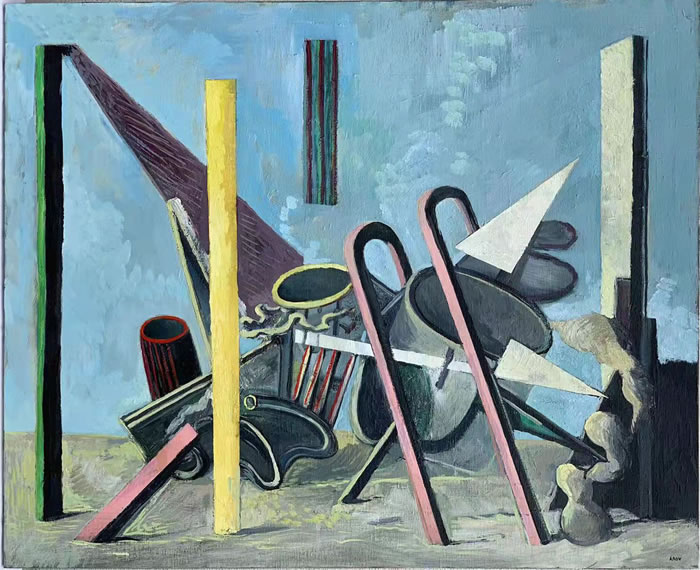
Peintures de formes 形式繪畫 81x100 cm
艾融的每件作品都像在講述一個沒有任何故事的短篇故事,其中包含無生命的角色(事物、結構圖案、墻)和有生命的角色(一些人物形象等)。你越看 Rémy Aron的藝術作品,這些存在的界限就越會消失。他們一切看似無序,但卻又井然有序,看似不和常規,但卻合乎情理。
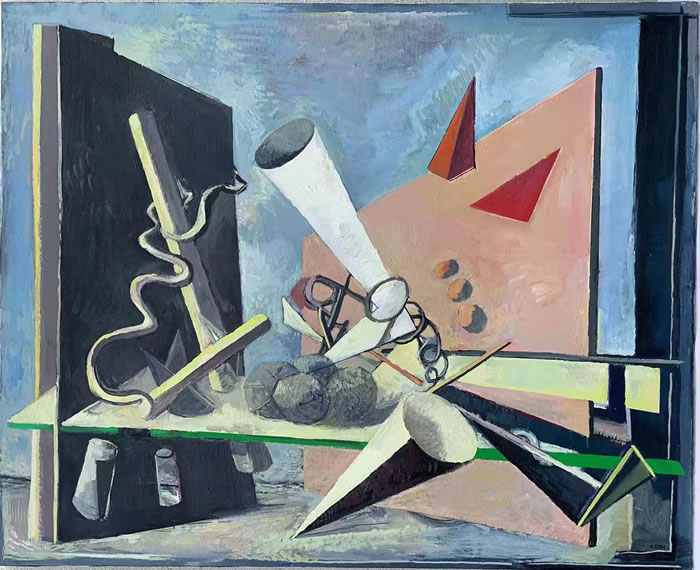
Nature morte 靜物100x81cm
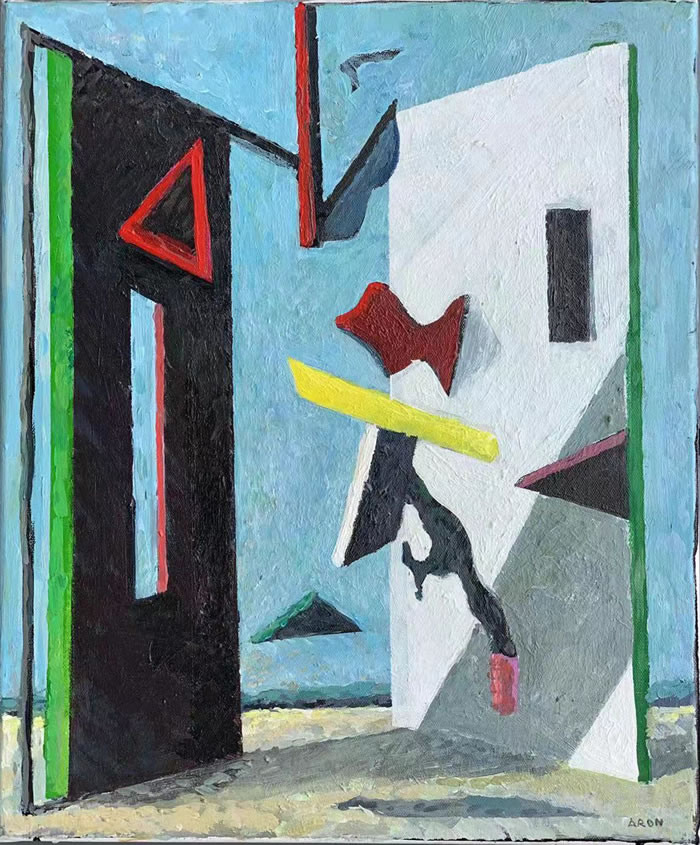
La fenêtre 窗 46x38cm
總之,雷米·艾融的作品將為您提供一些線索,讓您在生活的迷宮中去尋找自我。藝術家艾融和他的作品提出問題,引導觀眾,但從不給出答案,就像是一次迷宮中的自我“救贖”。
人總會在自己的迷宮中迷失方向,艾融的作品讓我們停駐,面對內心的每個角落開始沉思與交談。學會接受生活的混亂,在無序中找到自己的出口。
[1] 加繆(1913-1960),法國作家,哲學家,1957年諾貝爾文學獎得主,創立“荒誕哲學”。策展人Fred提到了他的作品《西西弗斯神話》,其他代表作有《鼠疫》、《局外人》被人熟知。
[2] 詹姆斯·喬伊斯(1882-1941),愛爾蘭作家,主要作品有《一個青年藝術家的自畫像》、《尤利西斯》、《芬尼根守靈夜》,其語言風格具有迷宮美學色彩。
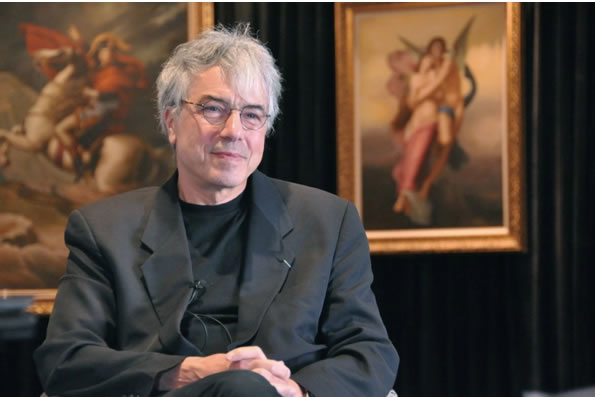
雷米·艾融Rémy ARON
雷米·艾融Rémy ARON
1952年4月16日出生於法國敘雷訥
Né le 16 Avril 1952 à Suresnes - France
法國美術家協會主席
Président de La Maison des artistes
文學藝術騎士勳章獲得者
Chevalier des arts et des lettres
畢業于巴黎美院
Diplôme des Beaux-Arts de Paris
中國國家畫院外籍研究員
Membre-chercheur de l’Académie nationale de peinture de Chine
法國造型藝術家協會(AFAP)主席
Président de l’AFAP, (Association française des arts-plastiques)
Meditating in the chaos and labyrinth of life
Prof. Dr. Fred Dervin, University of Helsinki, Finland
“I paint things that move forward and backward in the space of the painting. I try to find the spaces and surfaces that are as coherent as possible in order to experience calm and silence of a possible harmonious unity...”
“I start from the chaos of the canvas and of myself and I move towards order.”
This is how the French painter Rémy Aron (born in 1952), graduate of the Beaux-Arts de Paris, Research-Member of the National Academy of Painting of China and President of the French Association of Arts, instigator of the artistic movement entitled Spacism, describes his artistic work.
By opening the doors of this exhibition, you have just entered what I would like to call the labyrinth of life that,in his own modest ways,the artist invites us to explore.
In this exhibition introduction, I propose a guide to reading the exhibition through the motif and metaphor of the labyrinth.
A labyrinth is a closed and sinuous architectural ensemble(square or spiral-like), composed of rooms and corridors, with symmetrical and regular shapes, junctions, dead ends and false tracks, which are difficult for us to follow and grasp in its entirety. Figuratively, the word labyrinth is often used to refer to a complex situation or tortuous reasoning in many languages. The etymology of the labyrinth could refer to a (double) axe used for the sacrifice of the bull. The labyrinth is also said to come from Latin for labor (labor intus) and indicatesaarduous task. Similarly, we notice that it is not easy to circulate in Rémy Aron’s tortuous labyrinth, despite a misleading impression of familiarity (presence of everyday objects) and repetition (recurring forms) in his painting. It is necessary to work to circulate through his art.
The aesthetic motif and metaphor of the labyrinth have often been used across eras and continents to help people question their existence, identities, relationships with others. The labyrinth symbolises detours, deceptions, wanderings but also dangers. And the more I look at each of Aron’s works, the more I see his art as a call to take small moments of pause in the complexity of our existence. Aron seems to be asking us to stop in front of each work and to contemplate the world around us through things, shapes, sculptures, landscapes – and some silent human figures, as we will see later. All the works presented in this exhibition evoke, compose and problematize both chaos and this labyrinth of life. Aron serves as our guide, without pretending to be omniscient.
For the poet and art critic Jean-Clarence Lambert: “the labyrinthine form has always accompanied Man and in all parts of the world. It is probably as necessary to him as the circle, the straight line, the ellipse or the square as soon as he tries to order a conception of the world, and of his destiny in the world.” To add to what Lambert says, let me remind you that there are at least two forms of labyrinth: unicursal (a labyrinth with a single path, a tortuous path but without dead end where you cannot get lost) and multicursal (a complex labyrinth with loops, dead ends; we cannot but get lost). Aron accompanies us in a labyrinth of the multicursal type, each painting representing a loop and/or a dead end. Aron does not suggest onesingle path to take.
Let me justify now the use of the metaphor of the labyrinth to talk about Aron’s work. To begin with, it is important to remember that we can already find many uses of this metaphor in the arts, literature, the art of gardens (from the Renaissance) but also mathematics and even computer science. What is more, many civilizations have made use of labyrinthine shapes since prehistoric times, having engraved them for example on a tomb or organized them in stone paths. The Egyptians turned labyrinths into religious buildings thus representing an image of the world. In Greek mythology, the labyrinth was a palace built by Daedalus to enclose and hide the Minotaur, a half-man, half-bull creature. The hero Theseus killed the Minotaur in this labyrinth and escaped thanks to theso-called Ariane’s Thread that allowed him to trace his path back to the exit.In the Middle Ages, churches housed labyrinths, drawn on the floor, in order to trap demons becauseit was thought at the time that they only knew how to move forward by following a straight line. The labyrinth also symbolized the difficulty of accessing salvation for Christians. In India, the geometric diagram centered around an axis, the mandala (a Sanskrit term for circle) which serves as a meditation tool, also has a labyrinthine shape that recalls (among other things) the ‘map’of the human body, the house, but also the floor plan of a royal palace.China also invented different forms of labyrinth long before Western influence in the 18th century when the Jesuits built a labyrinth for the Emperor Qianlong, which the Chinese called a ‘garden’ because it reminded them of the shapes of Chinese gardens, inspired by celestial landscapes (xianjing). Labyrinthine forms are also present in other Chinese architectural elements such as imperial palaces and mausoleums (in Chinese, migong, the word for labyrinth, means ‘a perplexing palace’). The remote depth that these elements represent in China – which is reminiscent of Rémy Aron’s works – served to promote joy (see ecstasy) and spiritual greatness, while associating life and death with the cosmos.Moreover, the labyrinth in these Chinese elements evokes the Confucian concepts of you (wander) andle(joy), in relation to aesthetics, but also the concepts ofbian (change) and tong (deep awakening). It is perhaps not by chance that, seen from above, the multicursal labyrinth (with its dead ends and false roads), which Aron’s works urge us to question, forms a kind of nod to the symbolic forms of Chinese fu, lu and shou (blessings, prosperity, longevity).
In its different forms, through the ages and spaces, the myth of the labyrinth seems to symbolize Man who questions the ambiguity of his human condition but also the tensions between order and chaos. Depending on its position in space and time, the labyrinth reflects for Man infinity, but also confinement, disorientation and frustration. The labyrinth also has an initiatory dimension. It encourages us to take risks, and to explore, observe, move forward, walk around, choose, hesitate... Just like Sisyphus in Western thought or Wugang in China, and even if these tasks may seem monotonous and pointless, we have no choice: we must continue to live our labyrinthine condition. As such Camus (1913-1960) asks us to imagine Sisyphus ‘happy’ despite the disproportionate punishment inflicted upon him. Finally, James Joyce (1882-1941) also sees in the labyrinth a strong symbol of the artist’s condition...
Let’s go back to Aron now. In the paintings gathered here, the artist zooms in for us in the nooks and crannies of the labyrinth of life. We do not really know that we are in a labyrinth because each art work only reveals a tiny corner of the complexity of our existence. Aron does not show us the labyrinth from above, in its entirety, but in detail by offering moments of chaos, confusion, wandering but also tranquillity and meditation. Each painting also represents a kind of parenthesis in the labyrinth of life. Aron asks us to take a break, to observe the paths around us. He projects us forward while reminding us of the influence of the past and (perhaps) of what is coming. The labyrinth has no beginning, no end – only one entrance: existence. Aron shows us walls, corridors, doors, nooks and crannies... But no way out. We remain in the labyrinth. The labyrinth is within us, between us and between the world and us.
Let’s listen to Rémy Aron talk more about his work:
(It is about) self-discovery, an adventure and a discovery of the unexpected... As if my dictionary was naturefor a very long time, I work on the motif and love of space and the spectacle of the world. But today I work on this show, starting from the chaos of the self. When I am working, I need to resonate with myself and space and light, forgetting all kinds of learning, but seeking unity. The writing between nature and composition, which is done by simultaneous reactions of colors and values, in relation to each other, comes from deep experimentation on nature. Still lifes, characters, landscapes.
One could almost imagine that the artist is describing here for us a ‘piece’ of the labyrinth of life through his own philosophy of existence: ‘spectacle of the world’, ‘chaos’, ‘space and light’, ‘unity’. We find in his words the contradictory characteristics and tensions that the labyrinth forces us to explore. But just as the labyrinth does not impose anything on the one who tries to cross it, Aron lets us browse his painting and sharpen our own imagination. The titles of the works contain only one or two words, referring for example to an object (‘A Chinese lamp’), a concept (‘Constructions’), or describing in a few words, like a Japanese Haiku, the essence of aartwork (‘Expectations in a landscape’, ‘Morning sun’).
When we look ata work by Aron, we are both inside and outside our own existence – and that of others. One wonders where to go, which direction to take, which corner to explore, among all the forms, landscapes, things, small characters, contained in each painting. Color combinations (sometimes darker, sometimes more colorful) also contribute to these questions. A common point between most of the artworks is noticeable in the omnipresence of the ground, the sky and the horizon, which, even if they are sometimes ‘hidden’ by the encounters and dialogues of e.g. things, they remind us of where we are and who we are.By their (changing) presence in the works, these three elements (as in the labyrinth), reassure us and become forms of temporary escape when the rest turns out ot be too chaotic and confused. Similarly, the impression of repetition that we could (falsely) experience when looking at all the artworks (‘same’ landscapes, ‘same’ forms), can reassure us in this chaos of forms and objects. Here, Aron thinks of us too. He leaves us traces, threads to guide us. He also plays with our senses, leading us to both confusion and comfort. Each of Aron’s artworks asks us to concentrate, starting from the familiar to de-familiarize ourselves and vice versa.
We thus find hints of familiarity here and there in the paintings: specific places (a beach, a house, mountains, a wall, a window that opens onto the world); elements from nature (trees, plants, still life, bouquet, clouds); some recurring shapes (triangles, arrows, lines, air movements, spirals, which change colors), things (a trophy, a Chinese lamp, a curtain that flies in the wind, the plumb line that reminds us a little of Ariane’s Thread that can be used to orient oneself in the labyrinth). The appearance of these elements brings us back to the concrete in this universe always in motion and transformation. But what about the human in all this?Human figures are scarce in Aron’s paintings. Sprinkled here and there, humans are passive. They seem to be just part of the décor. They are waiting. They meditate. They dream. They doubt. They are hiding. While things, structures and landscapes are very animated in his works (they become ‘human’), human figures are transformed somehow into abandoned objects in the recesses of the labyrinth of life. We are therefore thrown into in universes beyond the human – anthropomorphic universes where the non-human dominates. For example, two pieces entitled ‘Conversations’ seem to represent what I perceive as two architect lamps interacting with each other. These things then become our mirror. They allow us to observe ourselves caught up in the chaos and labyrinth of life. We are moving away from our anthropocentric obsessions to better deal with chaos.Aron’s work is universal in this sense. He speaks to all of us, Chinese, Europeans and others. He strengthens our bonds in an era of widespread separation.
Generous, Aron gives us other keys to face our labyrinthine existence. The movements of things, forms, constructions, landscapes evoke the need to accept the in-/visible transformations of our existence. It seems interesting to me that, despite the solidity of most of the things that populate the paintings (‘hard’ objects, rocks, walls, tables ...), the movement and elasticity of life are fully felt. In a liquid world like ours, where everything seems disposable (data, ‘trash’ culture...), Aron reframes us in solid forms – but solids that adapt, transform, evaporate. We oscillate between joy, happiness, peace but also loneliness, doubt, anguish and (perhaps) disappointment. In these pieces of labyrinth, we question our truths and certainties again.
To finish, consider each of Aron’s artworksto be telling a short story without any story, with inanimate characters (things, structures, trees) and animated characters (some human figures). The more you look at Rémy Aron’s painting, the more the boundary between these characters will disappear. In the movements of things, forms and structures in the space of the works (see the notion of ‘spacism’ used by the artist), the inanimate becomes the animate and vice versa. Put together, Rémy Aron’s works will give you some clues to move forward and/or backward in the labyrinths of life that you have to cross day after day. Aron then becomes your multidirectional guide and your philosopher of life who asks questions but imposes no answers.
Then lose yourself in your own maze. Enter into dialogue with the things, constructions, spaces and forms that Rémy Aron offers us. Move forward, backward, hesitate, look to the sky. Meditate in front of each painting. Accept chaos. Find a path to better get lost ...




 主站蜘蛛池模板:
无码精品人妻一区二区三区影院|
国产亚洲欧美日韩俺去了|
88av在线播放|
在线成年视频免费观看|
男人j进女人p免费动态图|
国产成人黄网址在线视频|
亚洲欧美国产高清va在线播放|
自拍偷自拍亚洲精品播放|
思思久久99热只有频精品66|
在线观看国产剧情麻豆精品|
亚洲日本久久一区二区va|
欧美日本精品一区二区三区|
冠希与阿娇实干13分钟视频|
国产一区二三区|
99自拍视频在线观看|
国产成人精品亚洲2020|
樱桃视频影院在线播放|
一级特黄a大片免费|
久久精品无码专区免费青青|
五月婷婷在线免费观看|
国产综合激情在线亚洲第一页|
天天躁日日躁狠狠躁欧美老妇|
性欧美18一19sex性高清播放|
东北女人奶大毛多水多|
亚洲欧洲综合在线|
亚洲av无码一区二区三区不卡|
痴汉の电梯在线播放|
人妻无码一区二区三区免费|
中国在线观看免费的www|
日韩色图在线观看|
波多野结衣在线免费电影|
A国产一区二区免费入口|
麻豆精品传媒一二三区在线视频|
婷婷丁香五月中文字幕|
69久久夜色精品国产69|
黄色成人在线网站|
国99精品无码一区二区三区|
国产后入又长又硬|
波多野结衣bt|
污污免费在线观看|
免费高清a级毛片在线播放|
主站蜘蛛池模板:
无码精品人妻一区二区三区影院|
国产亚洲欧美日韩俺去了|
88av在线播放|
在线成年视频免费观看|
男人j进女人p免费动态图|
国产成人黄网址在线视频|
亚洲欧美国产高清va在线播放|
自拍偷自拍亚洲精品播放|
思思久久99热只有频精品66|
在线观看国产剧情麻豆精品|
亚洲日本久久一区二区va|
欧美日本精品一区二区三区|
冠希与阿娇实干13分钟视频|
国产一区二三区|
99自拍视频在线观看|
国产成人精品亚洲2020|
樱桃视频影院在线播放|
一级特黄a大片免费|
久久精品无码专区免费青青|
五月婷婷在线免费观看|
国产综合激情在线亚洲第一页|
天天躁日日躁狠狠躁欧美老妇|
性欧美18一19sex性高清播放|
东北女人奶大毛多水多|
亚洲欧洲综合在线|
亚洲av无码一区二区三区不卡|
痴汉の电梯在线播放|
人妻无码一区二区三区免费|
中国在线观看免费的www|
日韩色图在线观看|
波多野结衣在线免费电影|
A国产一区二区免费入口|
麻豆精品传媒一二三区在线视频|
婷婷丁香五月中文字幕|
69久久夜色精品国产69|
黄色成人在线网站|
国99精品无码一区二区三区|
国产后入又长又硬|
波多野结衣bt|
污污免费在线观看|
免费高清a级毛片在线播放|